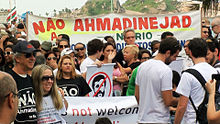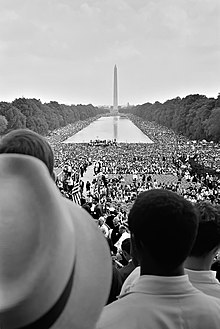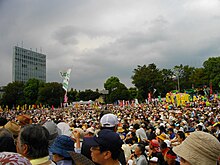Protest: Difference between revisions
OnBeyondZebrax (talk | contribs) fix dab |
OnBeyondZebrax (talk | contribs) fix dab |
||
| Line 1: | Line 1: | ||
{{other uses}} |
{{other uses}} |
||
{{redirect-distinguish|Remonstration|Demonstration ( |
{{redirect-distinguish|Remonstration|Demonstration (protest){{!}}Demonstration}} |
||
[[File:Demonstration against Ahmadinejad in Rio.jpg|thumb|Demonstration against the President of Iran [[Mahmoud Ahmadinejad]] during the [[United Nations Conference on Sustainable Development|Rio+20]] conference in [[Brazil]], June 2012]] |
[[File:Demonstration against Ahmadinejad in Rio.jpg|thumb|Demonstration against the President of Iran [[Mahmoud Ahmadinejad]] during the [[United Nations Conference on Sustainable Development|Rio+20]] conference in [[Brazil]], June 2012]] |
||
Revision as of 01:16, 12 May 2015




A protest (also called a remonstrance, remonstration or demonstration) is an expression of bearing witness on behalf of an express cause by words or actions with regard to particular events, policies or situations. Protests can take many different forms, from individual statements to mass demonstrations. Protesters may organize a protest as a way of publicly making their opinions heard in an attempt to influence public opinion or government policy, or they may undertake direct action in an attempt to directly enact desired changes themselves.[2] Where protests are part of a systematic and peaceful campaign to achieve a particular objective, and involve the use of pressure as well as persuasion, they go beyond mere protest and may be better described as cases of civil resistance or nonviolent resistance.[3]
Various forms of self-expression and protest are sometimes restricted[4] by governmental policy (such as the requirement of protest permits), economic circumstances, religious orthodoxy, social structures, or media monopoly. One state reaction to protests is the use of riot police. Observers have noted an increased militarization of protest policing, with police deploying armored vehicles and snipers against the protesters. When such restrictions occur, protests may assume the form of open civil disobedience, more subtle forms of resistance against the restrictions, or may spill over into other areas such as culture and emigration.
A protest can itself sometimes be the subject of a counter-protest. In such a case, counter-protesters demonstrate their support for the person, policy, action, etc. that is the subject of the original protest. In some cases, these protesters can violently clash.
Historical notions


Unaddressed protests may grow and widen into civil resistance, dissent, activism, riots, insurgency, revolts, and political and/or social revolution. Some examples of protests include:
- Northern Europe in the early 16th century (Protestant Reformation)
- North America in the 1770s (American Revolution)
- France in 1789 (French Revolution)
- The Haymarket riot, 1886, a violent labor protest led by the Anarchist Movement
- The Suffragette Movement Union Strikes in 1909 http://en.wikipedia.org/wiki/New_York_shirtwaist_strike_of_1909)
- Martin Luther King's 1963 March on Washington for Jobs and Freedom, a key moment in the Civil Rights Movement
- SOS (Save Our Sons) an Australian anti-conscription organization
- 1960s Protests against Vietnam War
- The Stonewall riots in 1969 protesting the treatment of homosexuals in New York City
- The Tiananmen Square protests of 1989
- The many ACT-UP AIDS protests of the late 1980s and early 1990s
- The Seattle WTO Ministerial Conference of 1999 protest activity against the World Trade Organization
- Anti-globalization Protests in Prague in 2000
- Anti-globalization Protests in Genoa from July 18 to July 22, 2001
- Feb. 15, 2003 Iraq War Protest
- Tea Party protests
- Palestinian First Intifada Second Intifada
- Anti-nuclear protests
- 2010 Thai political protests
- 2011 Iranian protests
- Arab Spring protests
- Impact of the Arab Spring
- 2011 Occupy Wall Street protests
- Taksim Gezi Park 2013
- June 2013 Egyptian protests
- Euromaidan protests in Ukraine, Nov. 2013 through Feb. 2014
- Black Lives Matter
Forms of protest
Commonly recognized forms of protest include:
Public demonstration or political rally
Riots do not count as protests or protected 1st Amendment Speech.[citation needed]



Some forms of direct action listed in this article are also public demonstrations or rallies.
- Protest march, a historically and geographically common form of nonviolent action by groups of people.
- Picketing, a form of protest in which people congregate outside a place of work or location where an event is taking place. Often, this is done in an attempt to dissuade others from going in ("crossing the picket line"), but it can also be done to draw public attention to a cause.
- Street protesters, characteristically, work alone, gravitating towards areas of high foot traffic, and employing handmade placards such as sandwich boards or picket signs in order to maximize exposure and interaction with the public.
- Lockdowns and lock-ons are a way to stop movement of an object, like a structure or tree and to thwart movement of actual protesters from the location. Users employ various chains, locks and even the sleeping dragon for impairment of those trying to remove them with a matrix of composted materials.
- Die-ins are a form of protest where participants simulate being dead (with varying degrees of realism). In the simplest form of a die-in, protesters simply lie down on the ground and pretend to be dead, sometimes covering themselves with signs or banners. Much of the effectiveness depends on the posture of the protesters, for when not properly executed, the protest might look more like a "sleep-in". For added realism, simulated wounds are sometimes painted on the bodies, or (usually "bloody") bandages are used.
- Protest song is a song which protests perceived problems in society. Every major movement in Western history has been accompanied by its own collection of protest songs, from slave emancipation to women's suffrage, the labor movement, civil rights, the anti-war movement, the feminist movement, the environmental movement. Over time, the songs have come to protest more abstract, moral issues, such as injustice, racial discrimination, the morality of war in general (as opposed to purely protesting individual wars), globalization, inflation, social inequalities, and incarceration.
- Radical cheerleading. The idea is to ironically reappropriate the aesthetics of cheerleading, for example by changing the chants to promote feminism and left-wing causes. Many radical cheerleaders (some of whom are male, transgender or non-gender identified) are in appearance far from the stereotypical image of a cheerleader.
- Critical Mass bike rides have been perceived as protest activities. A 2006 New Yorker magazine article described Critical Mass' activity in New York City as "monthly political-protest rides", and characterized Critical Mass as a part of a social movement;[5] and the UK e-zine Urban75, which advertises as well as publishes photographs of the Critical Mass event in London, describes this as "the monthly protest by cyclists reclaiming the streets of London."[6] However, Critical Mass participants have insisted that these events should be viewed as "celebrations" and spontaneous gatherings, and not as protests or organized demonstrations.[7][8] This stance allows Critical Mass to argue a legal position that its events can occur without advance notification of local police.[9][10]
- Toyi-toyi is a Southern African dance originally from Zimbabwe that became famous for its use in political protests in the apartheid-era South Africa, see Protest in South Africa.
Written demonstration
Written evidence of political or economic power, or democratic justification may also be a way of protesting.
- Petitions
- Letters (to show political power by the volume of letters): For example, some letter writing campaigns especially with signed form letter
Civil disobedience demonstrations
Any protest could be civil disobedience if a “ruling authority” says so, but the following are usually civil disobedience demonstrations:
- Public nudity or topfree (to protest indecency laws or as a publicity stunt for another protest such as a war protest) or animal mistreatment (e.g. PETA's campaign against fur). See also Nudity and protest.
- Sit-in
- Raasta roko (people blocking auto traffic with their bodies)
As a residence
- Peace camp
- Formation of a tent city
- Camp for Climate Action
Destructive
- Riot - Protests or attempts to end protests sometimes lead to rioting.
- Self-immolation
- Suicide
- Hunger strike
- Bombing
Non-Destructive
- Silent Protests[11] - Protests/Parades in which participants are nonviolent and ususally silent, in attempt to avoid violent confrontation with Military or Police Forces. This tactic was effectively used during the Arab Spring in cities such as Tehran and Cairo
Direct action
Protesting against a government

Protesting against a military shipment
- Port Militarization Resistance - protests which attempt to prevent military cargo shipments.
By government employees

Job action
In sports
During a sporting event, under certain circumstances, one side may choose to play a game "under protest", usually when they feel the rules are not being correctly applied. The event continues as normal, and the events causing the protest are reviewed after the fact. If the protest is held to be valid, then the results of the event are changed. Each sport has different rules for protests.
By management
By tenants
By consumers
Information
- Informative letters, letter writing campaigns, letters to the editor
- Teach-in
- Zine
- Soapboxing
Civil disobedience to censorship
By Internet and social networking

Blogging and social networking have become effective tools to register protest and grievances. Protests can express views, news and use viral networking to reach out to thousands of people.
Literature, art, culture
Protests against religious or ideological institutions
Economic effects of protests against companies
A study of 342 US protests covered by the New York Times newspaper in the period 1962 and 1990 showed that such public activities usually had an impact on the company's publicly traded stock price. The most intriguing aspect of the study's findings is that what mattered most was not the number of protest participants, but the amount of media coverage the event received. Stock prices fell an average of one-tenth of a percent for every paragraph printed about the event.[13]
See also
References
- ^ "Thousands march against nuclear power in Tokyo". USA Today. September 2011.
- ^ St. John Barned-Smith, "How We Rage: This Is Not Your Parents' Protest," Current (Winter 2007): 17-25.
- ^ Adam Roberts, Introduction, in Adam Roberts and Timothy Garton Ash (eds.), Civil Resistance and Power Politics: The Experience of Non-violent Action from Gandhi to the Present, Oxford University Press, 2009, pp. 2-3, where a more comprehensive definition of "civil resistance" may be found.
- ^ Daniel L. Schofield, S.J.D. (November 1994). "Controlling Public Protest: First Amendment Implications". in the FBI's Law Enforcement Bulletin. Retrieved 2009-12-16.
{{cite web}}: Italic or bold markup not allowed in:|publisher=(help) - ^ Mcgrath, Ben (November 13, 2006). "Holy Rollers".
- ^ "Critical Mass London". Urban75. 2006.
- ^ "Pittsburgh Critical Mass".
- ^ "Critical Mass: Over 260 Arrested in First Major Protest of RNC". Democracy Now!. August 30, 2004.
- ^ Seaton, Matt (October 26, 2005). "Critical crackdown". London: The Guardian. Retrieved May 22, 2010.
- ^ Rosi-Kessel, Adam (August 24, 2004). "[*BCM*] Hong Kong Critical Mass News".
- ^ D. Parvaz , Iran's Silent Protests
- ^ Adam Roberts and Timothy Garton Ash (eds.), Civil Resistance and Power Politics: The Experience of Non-violent Action from Gandhi to the Present, Oxford: Oxford University Press, 2009. ISBN 978-0-19-955201-6.[1]
- ^ Deseret Morning News, 13 Nov. 2007 issue, p. E3, Coverage of protests hurts firms, Cornell-Y. study says, Angie Welling
External links
 Media related to Protests at Wikimedia Commons
Media related to Protests at Wikimedia Commons
